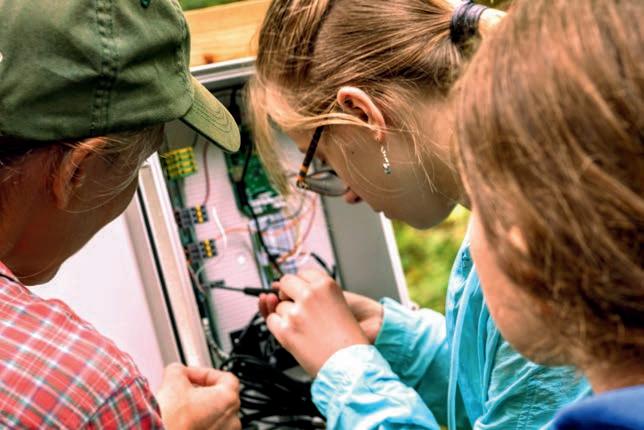St. Paddy’s Day
Soloists, cellist join Hinesburg Artist Series concert
Page 3

State champs
Girls’ Nordic team wins
Division I title
Page 12

March 7, 2024

St. Paddy’s Day
Soloists, cellist join Hinesburg Artist Series concert
Page 3

State champs
Girls’ Nordic team wins
Division I title
Page 12

March 7, 2024
Residents vote down town manager petition
LIBERTY DARR STAFF WRITERThe looming question of whether Charlotte would switch to a town manager form of government was officially put to rest, at least for now, when residents shot down the move in a 587-799 vote at the polls Tuesday.
“We certainly gained recognition of the option for a town manager,” said Lane Morrison, a member of the group that circulated a petition for the switch said, adding the group would consider taking the question up again when there is another retirement in town offices. “But it’s very difficult to overcome the selectboard being against the change in governance.”
With more than 1,400 voters turning out on Tuesday, residents approved the town’s municipal budget and other ballot questions while also voting in a fresh face to the selectboard.
See CHARLOTTE on page 11

Hinesburg voters on Tuesday approved the town’s $5.4 million budget while the two incumbents were reelected to the selectboard.
The spending approval means town residents will see a 4.3
percent municipal tax rate increase for fiscal year 2025. It translates into a $25.90 increase per $100,000 of assessed value.
In crafting the budget, town officials sought to keep expenses level funded, just as they did last year when developing this current year’s budget.

Merrily Lovell, the chair of the selectboard, said the town worked “diligently with the town manager to reduce costs this year.”
“It was actually painful because there many valid requests for increases from many committees and we just level funded expenses whenever it was possible,” she said.
FARMHOUSE TAP & GRILL
EL


Town residents approved a variety of articles, including the $2,012,928 general government budget (804-593), the $846,806 highway department budget (994-410), the $633,944 police
See HINESBURG on page 10





Gardener’s Supply, a company that provides environmentally friendly gardening products from its headquarters in Burlington, is set to expand its facilities with a seasonal nursery and retail site at 2545 Shelburne Road — the former location of the old Sirloin Saloon.
David Marshall, the engineer with the project, presented to the town’s development review board last week plans for five buildings totaling 6,432 square feet— including a greenhouse, nursery, point of sale building, and retail space — that would be reminiscent of their classic retail facilities at their other locations in Williston and Burlington.
“The nursery would operate from early May, late April for the heart of the season through fall,” Marshall said. “They would like to stay open for Christmas tree sales and seasonal activities like that. But by the middle of December, they
would be pretty much closing up shop in regard to the operations.”
Pat Pearsall, the retail operations manager for Gardener’s Supply, explained that although this location will be much smaller than the company’s other sites, it will still provide fan favorites like potted plants and other limited gardening supplies like soil, fertilizer, seeds and a few other natural adjacencies.
“This particular operation is not going to be a year-round operation,” Pearsall said. “Most of the business we will do will be outside so the building is going to be small, mostly for our employees. Most of the space outside is going to be potted plants on the ground or on benches. So pretty movable.”
This property sat vacant since the Sirloin Saloon closed in 2008 until a food truck owned and operated by Morgan Brook Farm opened seasonally just last year. It’s set to return this summer.
Pearsall said Gardener’s Supply is excited to work with the food

truck to create a unique experience for people looking to get food, but still having access to their open garden area.
“The intention is to have seating there with a green backdrop so that they’re kind of having both experiences,” he said. “They’re outside the fence but they’re kind of still in the garden center. We think it’d be great to the spot.”
The plan, which is set to mimic a more complex garden roadside stand, is also a new concept for the company as they look toward expansion options different than just their traditional retail stores.
“This is also a concept for us: Does this work? Is this something we can do somewhere else?” Pearsall said.
The site will have 50 parking spaces, but the project will also include a pedestrian walkway from Route 7 into the site with bicycle parking provided near the main entrance.
Keeping in line with the company’s dedication to environmentally friendly resources, the small 72 square-foot point-of-sale building is made entirely out of recycled water bottles and has solar-power capability, although since business hours are set to run from 10 a.m. until 6 p.m. it’s not anticipated to use much electricity.
“It’s shaped like a container, and we did brand it with our mission statement and our logo,” said Pearsall.
Although there was some voiced concern around the anticipated influx of traffic, the approval was granted by the review board last week, and the team is set to open its doors in just two months.
Multiple residents, like professional landscaper Tracy Beardin, showed overwhelming support for the project, with the only complaint being that the retail facility isn’t larger.
“I think that this is going to be a huge success, especially being open on Route 7,” she said.


As a celebration of bringing joy and music to the community, the Hinesburg Artist Series will present its 25th anniversary St. Patrick’s Day concert featuring the “Requiem for the Living” by Dan Forrest on Sunday, March 17.
The South County Chorus and Hinesburg Artist Series Orchestra will perform with guest soprano Cristina Escobedo and tenor Cameron Brownell, and soloists Gary Moreau, baritone, and Jiwon Lee, cellist, with musical director Rufus Patrick.
Performances will be held 2 p.m. and again at 4:30 p.m. at St. Jude Catholic Church in Hinesburg.
“This concert promises to be one of our most inspiring performances,” Patrick said. “The ‘Requiem’ is incredibly moving, and we are very excited to share the joy of this spectacular music.”
The chorus and orchestra will also present “A Song of Peace,” “May the Road Rise to Meet You,” and “Spirit Suite II,” arranged by Mark Hayes. The orchestra will play “Irish Suite, Part 2,” and the ensembles will perform a group of Irish music, including “Kesh Jig,” “Star of the County Down” and Coleraine jigs.
“We are so fortunate to have this opportunity to come together to make music
like this in Hinesburg,” soprano Karen Farnsworth, who has been singing with the Hinesburg Artist Series since it began, said. “We really feel a special connection with so many loyal audience members and are always excited to see others discover the high quality we bring to a local perfor mance.”

Escobedo will sing with the chorus and perform “Te quiero digiste” by Maria Grever and “The Silver Aria” from “The Ballad of Baby Doe” by Douglas Moore. Escobedo, born in Lima, Peru, is getting ready to sing the role of Anina in “La Traviata” by Giuseppe Verdi with the Vienna Opera Academy in July.
Brownell will also sing with the chorus and perform “Simple Song” from the Mass by Leonard Bernstein. Brownell is the vocal music teacher at Champlain Valley Union High School and the music director at Charlotte Congregational Church. He is also the assistant conductor of Solaris Vocal Ensemble.
Lee is a returning guest soloist and she will perform an arrangement of “Be Thou My Vision” arranged by Gary Lanier.
Tickets for the concert are $25 (free for children under 12) and available at the door or at the hinesburgartistseries.org.








Total incidents: 27
Feb. 27 at 9:44 a.m., a late reported motor vehicle crash was investigated.
Feb. 27 at 8:25 p.m., an officer served court paperwork to a resident on Hillview Terrace.
Feb. 28 at 7:30 a.m., suspicious activity was investigated on Ballard’s Corner Road.
Feb. 28 at 8:10 a.m., an officer investigated a resident dispute on Pond Road.
Feb. 29 at 2:30 p.m., five individuals were assisted with fingerprinting for employment purposes.
Feb. 29 at 8:05 p.m., suspicious activity on CVU Road was investigated.
Mar. 1 at 9:05 a.m., an officer investigated a traffic hazard on Place Road West.
Mar. 2 at 1:15 p.m., suspicious activity on Hillview Terrace was investigated.
Mar. 3 at 12:25 p.m., an officer assisted another agency with a death notification.
Mar. 4 at 12:35 p.m., an officer investigated a theft at the Jiffy Mart on Ballard’s Corner Road.
Mar. 4 at 4:30 p.m., police investigated suspicious activity on Charlotte Road.
Feb. 29 at 2:30 a.m., after being called to a home on North Road for a family disturbance, police arrested Joseph Robar, 37, of Hinesburg, for violating an abuse prevention order, violating conditions of release and resisting arrest. Police say Robar violat-
ed several court-ordered conditions of release and an active abuse prevention order. Later in the day, while trying to arrest Robar, he resisted, police say. He is being held without bail at the Northwest State Correctional Facility.
Advertising
Wendy Ewing wendy@shelburnenews.com (802) 985-3091 x12
Advertising Director
Judy Kearns judy@otherpapersbvt.com (802) 864-6670 x21
News Editor
Tommy Gardner
Staff Writers
Aaron Calvin Corey McDonald
Liberty Darr
Production Manager
Stephanie Manning stephanie@shelburnenews.com
Editor/Publisher Gregory Popa gpopa@stowereporter.com
Rep. Chea Waters Evans
It’s town meeting, so the Legislature is off for the week. This is a good time for me to answer emails and phone calls. I try hard to get back to people right away, but sometimes things fall through the cracks and for that I apologize. I’m going to spend the week making sure I’m all caught up. I’m writing this the day before election day, so I don’t know how the school budget vote came out, so there’s nothing new or different happening on that front at the moment.
Federal Emergency Management Agency.

Last year, the Big Bill faced some resistance from lawmakers who were concerned about the state ending a motel and hotel program that provided housing for unhoused Vermonters. This time around, the Budget Adjustment Act includes an $80-per-night cap on payments to motel and hotel owners from the state. This will manage the expenses of the program and alleviate issues that arose last year from some owners charging more than they should have, and the state just paying those rates because they didn’t really have other options.
Last week, we passed the budget adjustment, also known as the Budget Adjustment Act. This is the mid-fiscal-year bill that adjusts and balances the current budget, also known as the Big Bill, which is the last thing we pass at the end of the session in May. The budget adjustment takes into account any unexpected circumstances over the past six months and also adjusts for money that wasn’t needed where we anticipated it would be.
Billing inquiries Leslie Lafountain leslie@stowereporter.com (802) 253-2101
Advertising submission deadline: Friday at 5 p.m. advertising@thecitizenvt.com classifieds@thecitizenvt.com
Editorial submission deadline: Friday at 5 p.m. news@thecitizenvt.com
Calendar submission deadline: Friday at 12 p.m. news@thecitizenvt.com
Contact: 1340 Williston Road South Burlington, VT 05403 (802) 985-3091
The Citizen is published weekly and mailed free to residents and businesses in Charlotte and Hinesburg and rack distributed at select high traffic locations. The Vermont Community Newspaper Group LLC assumes no responsibility for typographical errors in advertisements and reserves the right to refuse advertising and editorial copy.
This year, a huge chunk of money — yes, that’s an official budgeting term — went to aid for communities affected by last year’s flooding: $23.5 million from the state general fund and $30 million required in matching funds to receive money from the
Though we’re off this week, there’s still a lot of work to be done behind the scenes. The two weeks we’re back lead up to crossover, which is the date on which all bills need to be out of their chamber — voted out of either the House or Senate — and sent over to the other. If a bill doesn’t make it out of a committee and onto the floor by then, it’s dead. (Unless it’s a committee bill, which is created by an entire committee and not just one person or group of people, or a town charter, which can be sent through at any time.)
This year is the second year of the biennium, which means that any bills that don’t make it through will have to be reintroduced in the next biennium.


Some bills take years, and multiple bienniums, to pass, and some are reintroduced many times and never go any farther.
One bill we’re anticipating from the Senate, S.55, tackles the future of open meeting laws and how town meetings will be held in the future. During COVID19, exceptions were made to open meeting law requirements, particularly the ones relating to mandating a physical location of a meeting, because, if you remember, we weren’t allowed to go anywhere near each other. We extended those exceptions last year, but those temporary rules expire in July.
Charlotte has held an Australian ballot vote since those temporary laws were created; this year, again, there is no physical town meeting. Fun fact: Charlotte can’t hold an Australian ballot vote to decide if we want to switch from a town meeting voting format to Australian ballot voting format — the vote must be held in the manner in which the town usually votes, which in Charlotte’s case is through a town meeting.
So, there will be at least one more town meeting in our future. I’m sure the coming year will be full of debates and conversations about how to preserve this beloved tradition while getting the maximum number of voters to the ballot.
A hot topic in the Senate bill is whether towns should be required to hold hybrid meetings. I think they’ve worked wonderfully in Charlotte. So many people can log in who normally wouldn’t have been able to due to health concerns, kids’ bedtimes, work or time constraints and many other reasons. It’s really increased participation and engagement, which is terrific.
The hesitation to require it by law is that some towns don’t have reliable broadband access (we’re working on that, too) and that it will require towns to spend money they might not have. I hope that no matter how it turns out, we keep holding hybrid meetings.
Feel free to be in touch any time–917-887-8231 or cevans@ leg.state.vt.us. I’ll hold another constituent meeting in Charlotte soon and hope to head over to Hinesburg soon as well.
Chea Waters Evans, a Democrat, represents Charlotte and Hinesburg in the Chittenden-5 House district.
Has anyone not heard about drug addiction problems in Vermont? About substance use in municipalities and neighborhoods?
Residents have found used needles near local schools and friends and families are severely affected by the loss of loved ones from addiction or death. Some people are so intimidated by drug dealers that they are leaving their apartments or made to live with drugs being sold in their homes.

Overdose deaths in Vermont in 2021 totaled 217. In 2022 the final count of deaths from overdose is predicted to be over 243. These are preventable deaths, and this is an unacceptable trajectory. As long as there is demand for addictive substances, these problems will persist. There is not one solution to bending the curve on addiction or the demand for opioids and other addictive substances. As reported in earlier op-eds, my legislative activity includes work on short-term and long-term intervention, prevention and treatment programs for the chronic diseases of addiction.
required for those in early stages of withdrawal, those living in recovery homes and or for those in larger community recovery centers.
Ultimately, the goal is to provide an opportunity for those in recovery to seek employment and re-enter the community. When passed the bill will suggest appropriate licensing or certification criteria for types and levels of recovery programs and housing. The National Association of Recovery Residences and consultants are working with legislators, the administration and recovery professionals to finalize S.186.
The goal is to clarify what is needed and when and how to move people into recovery, employment and an environment or community different from the one that caused their addiction. Money and resources are needed to build recovery support services in Vermont. Opioid settlement funds should help.
include lack of transparency, complex pricing and lack of regulation at federal and state levels.
We will complete legislative work on S.186 and H.72 in the next few weeks. H.72 will allow for the establishment of a safe haven for those with addiction at overdose protection centers. They have been called safe injection sites or harm reduction centers and they can help save lives.
Among other services, these centers provide testing of street drugs that addicted people intend to use, immunity from prosecution when users are at the centers and ongoing counseling or referrals. The benefits of these centers are lifesaving and provide improved outcomes for those with substance use disorder.
Local communities also benefit from a reduction in needles or related drug paraphernalia left behind in streets or buildings. Using money from Vermont’s opioid settlement to establish these centers makes sense. Hopefully H.72 can provide critical intervention for people addicted to opioids and other drugs and help those sick with addiction move toward recovery. As we know, recovery is a lifelong process requiring long-term attention to the disease of addiction.
S.186 would establish a system of recovery. The bill helps coordinate recovery residences of different levels for patients in recovery. Different services are
Vermonters also face increased prescription drug costs, out of pocket costs, increased insurance premiums and limited access to care. One of the cost drivers for increased school funding is health insurance premium increases for school teachers and staff. Insurers and medical providers alike identify high prescription drug costs as a reason for double digit increases in hospital or premium costs.
One expert provided the following context to my Senate Committee on Health and Welfare:
“As biopharmaceutical science and technology rapidly evolve to produce meaningful products, society’s inability to manage the very high costs of innovation has grown commensurately. Increasingly, pharmaceutical market pricing requires significant societal and individual trade-offs to finance access to important medicines. Those trade-offs occur inside and outside of health care and become harder and harder to accept.”
Tradeoffs might be a decision to buy needed prescription drugs for chronic illness or pay rent or buy food. Cost for the introduction of a new cancer drug grew 53 percent between 2017 and 2022 to $218,000. The cost of one arthritis drug increased 60 percent over five years and provided significant corporate profits.
Prescription drugs represent 23 percent of health care premiums. This exceeds the proportion spent on hospital inpatient services. No wonder insurance companies stress that premium increases reflect increases in prescription drug costs. And no wonder prescription drug pricing drives difficult personal choices. The dysfunction in today’s pharmaceutical market places pressure on all of us. We are held hostage
to a pricing system that is a black box. The pharmaceutical industry sells drugs in the U.S. at much higher prices than other countries. U.S. residents pay 33 percent more for prescription drugs than those in the United Kingdom and 25 percent more than those in Canada.
Reasons for higher drug costs include lack of transparency, complex pricing and lack of regulation at federal and state levels. My committee is working on S.98, which will begin to address regulation of prescription drug costs in Vermont. The bill gives the Green Mountain Care Board authority to establish upper price limits. Regulatory work in Maryland, Oregon and Colorado has paved the way
to demonstrate that savings can be realized by lowering cost of drugs that patients in those states need.
We have heard concerns from patients with chronic illnesses like diabetes, cystic fibrosis or arthritis about restricted access to the high-cost drugs they need to survive. They fear that a pharmaceutical company might limit sales of prescription drugs. That fear has not been realized in other states.
Ginny Lyons, a Democrat from Williston, represents South Burlington, Charlotte, Hinesburg, Shelburne and several other towns in the Chittenden-Southeast Senate district.


When I first played Old Maid as a child, I thought the old maid in question was an elderly housekeeper. That’s understandable, though it didn’t make the title of the card game any less offensive.
Obviously, I eventually learned, to my future dismay, that the Old Maid is an unmarried woman of advanced years. A pejorative term used for fun. Moreover, I got the message that to end up an old maid was shameful and to be avoided at all costs.
After all, there’s an entire industry about a woman’s “one special day” to walk down the aisle. But couldn’t her happily-ever-after be earning a master’s degree? Running a business? Retiring early? Or paying off her mortgage?

My childhood was laden with excessive and unrealistic messaging about love and marriage. I can’t count the number of different Cinderellas I’ve heard sing, “Some Day My Prince Will Come.” Even today’s television shows like “The Bachelor” and “Love is Blind” continue to show that the dominant cultural warning for women is still the same. Don’t be an old maid.
Getting married isn’t just the expectation, it’s somehow become an unseen, yet imposing, yardstick to measure the viability and worth of a woman. It’s an unspoken judgment that says if you’re caught being the old maid, you lose. Not just in cards, but in the game of life.

A moment for a station break, please. I have nothing against marriage. In fact, I love it. I’m married to someone I’d marry again. What I am against is the marginalization of any woman for any reason. Besides, isn’t one’s relationship status nobody else’s concern or right to judge?
Of course, I didn’t always think this way. I, too, was indoctrinated, unknowingly waiting to be married because, unconsciously, wedlock was presumed. It’s probably why I got it wrong the first time. That and all the hardscrabble years sitting on an unyielding pew absorbing a limited view of matrimony, especially one that has to fulfill its procreative purpose “until death do us part.”
Admittedly, I also used to believe that everybody should have children. OK, I had to get off the floor after even typing that. How ridiculous! What can I say? I was young, immature and too busy playing Milton Bradley’s Mystery Date.
All this brings me to the word spinster and how it’s used to describe an older unmarried woman. One of its synonyms is
THECITY OFBURLINGTON

This is your opportunity to meet with our City department representatives and apply for any of our open positions. Explore career opportunities for full-time and part-time, temporary, seasonal roles and internships.
We offer a competitive and comprehensive benet package, including health, dental, life insurance, retirement plan, FSA and much more!
We believe in promoting a culture that reveres diversity and equity. The City of Burlington is proud to be an equal opportunity employer, and we are strongly committed to creating a dynamic and equitable work force.
No advanced registration required; register upon arrival.
www.burlingtonvt.gov/HR/jobfair
old maid. But is she?
From the late 14th century, spinster originally meant “a woman who spins, female spinner of thread.” By 1719, it was being used to describe a single woman regarded as too old for marriage.
It’s great that we live during a time where calling women spinsters is understood to be both dated and derogatory. And that’s not counting the additional aspersions the word spinster has accumulated over the years: unmarriable, prudish, unattractive and undesirable.
Just sit with that a moment while contemplating that their male counterparts are called bachelors. A word that implies eligibility, bon vivant vibes and desirability.
What if we go further and don’t cast aside the word spinster and instead hold it with respect to how it was first used? “A woman who spins.” A crafter, an entrepre-
neur, a contributor. Likewise, let’s once and for all agree that a woman’s value is not defined by her marital status. At any age.
Now, as far as Old Maid, it can be a fun game. One which can be called whatever you like and played with any regular card deck.
Meanwhile, I’m sorry to say Old Maid cards with representations of elderly women are still being produced, sold and purchased with the same name. Online reviews assure the stigma will continue: “My grandsons love this game.” “It was easy to play with my daughters.” “We play it with our five-year-old and the younger kids love to watch and learn.” I’m sure they do. But what exactly are they learning?
Carole Vasta Folley is an award-winning columnist and playwright. Visit carolevf.com for more info.

A bobcat and two red-tailed hawks found dead in Cornwall have tested positive for highly pathogenic avian influenza virus infection, according to preliminary lab results shared with the Vermont Fish and Wildlife Department on Feb. 15.
The department is now awaiting the results of a confirmatory second test, which may take several weeks to receive.
The avian influenza virus has been circulating in Vermont since 2022 and has been reported in wild birds including hawks and eagles as well as domestic fowl. The bobcat that tested positive this month is the first detection of virus in a mammal from Vermont.
It is uncommon in mammals, however, there have been detections in mammals in many other states including Connecticut, Maine and New York.
Although mammals infected with avian
influenza virus infection are always of interest to wildlife officials, the risk to people from viruses remains low according to the Centers for Disease Control and Prevention.
“Our recommendations to Vermonters are the same as they’ve been since HPAI was first detected in our state — mainly, to avoid direct contact with wild birds,” David Sausville, wildlife management program manager with the Vermont Fish and Wildlife Department, said. “Observe wild birds only from a distance and practice good hygiene around domestic fowl. Practice good biosecurity by keeping domestic fowl and other pets away from areas where wild birds gather, like bird feeding stations or duck ponds.”
More information on best practices around wild birds is available on the Vermont Fish and Wildlife Department’s website.
Trish O’Kane is the first to admit that for a long time, she didn’t care about birds. It wasn’t that she didn’t like them; she was too focused on human problems to even notice them.
Now a senior lecturer at the University of Vermont’s Rubenstein School for the Environment and Natural Resources, the Burlington resident was a longtime journalist in war-torn Central America, human rights activist and writing instructor before she began her mid-life journey to earning a doctorate in environmental studies at the University of Wisconsin.
O’Kane will read from and talk about her new book, “Birding to Change the World: A Memoir” (Ecco, 2024) on Wednesday, March 20, 6:30 p.m., at the Pierson Library in Shelburne.
In her book, she chronicles how her life and worldview changed completely when she first noticed birds in the post-Hurricane Katrina devastation outside her ruined New Orleans home. Suddenly, the bright red male cardinal she began watching becomes “the most precious being on Earth,” a symbol of hope, a consciousness-raiser about environmental destruction but also resilience, and the first signpost on her path to a new career.
While working on her doctorate in Madison, O’Kane lived across the street from Warner Park, a 214-acre community oasis, home to over 150 species of birds and many animals. The park, situated in a working-class neighborhood, its wildlife and the coalition O’Kane and others form to save the park from further development become the emotional and scientific heart

of her journey from accidental birder to obsessive one, shaping her dissertation and life’s trajectory.
Eventually, Warner Park turns into a de facto outdoor classroom where O’Kane takes middle schoolers on birding outings and teaches them to care about the natural world around them, especially the birds. Those afternoons become the nucleus for the wildly popular course O’Kane creates there and now teaches at UVM, “Birding to Change the World.”
It mixes elements of outdoor environmental education, exercise, mentorship, activism and ornithology. O’Kane trains her college students to become mentors to children at Flynn Elementary School in Burlington, and every week during the semester, regardless of weather conditions, they spend the afternoon outdoors with their mentees. They explore around Derway Island in the Winooski River, learn about birds and the environment and build relationships that empower and inspire mentors and mentees alike.
O’Kane writes eloquently and
lyrically about her transformation, mixing science and pedagogy with wonderful storytelling, all in the hopes of enlisting others in her causes. She is upfront and unapologetic about doing so.
“First of all, there are 48 million birders in the U.S. If even half a million people heard about the book and would do something on behalf of the birds” it would be incredible, she says. “We’ve got to act now, or we’re going to lose them. Birds remind me of what is possible, and at this moment when so many feel disempowered, birds need us to act out of love and in whatever ways we can and feel appropriate to help them.”
She is even more passionate about her second hope for the book: Highlighting the urgent need to get kids outside in nature, and to bring back recess periods so that children can benefit from fresh air and physical exercise.
“We are making them sick, keeping them inside,” she argues. “The solution is simple. Many schools have lovely yards, but the kids are sitting at desks, and they’re on meds. Studies show that this is absolutely wrong. We can resolve many of their behavioral problems just by getting those kids outside.”
Just as O’Kane herself can’t be contained by the walls of a traditional classroom, her book refuses to be neatly categorized, either. It is part memoir, part love letter to birding, part clarion call to action but always wholly engaging.
Lucie Lehmann serves on the board of The Green Mountain Audubon Society, which is co-sponsoring O’Kane’s talk and book signing on March 20 at 6:30 p.m. at The Pierson Library. The Flying Pig Bookstore will sell books at the event, which is free and open to the public.











The Age Well meal pickup for Thursday, March 14, is from 10 to 11 a.m. at the Charlotte Senior Center features beef round, boiled potatoes, cabbage and carrots in beef stock, wheat roll, butter, leprechaun cake with frosting and milk.
You must pre-register by the prior Monday at 802-425-6345 or meals@charlotteseniorcentervt. org.
The meal on Thursday, March 21, features roast pork with sauce, mashed yams, peas and onions, wheat bread with butter, oatmeal, raisin cookie and milk.
The suggested donation is $5. Check the website for last-minute cancellations at bit.ly/3FfyLMb.
Charlotte’s East and West Villages Project kicks into high gear this month, with two opportunities for residents to influence the shape of things to come.
Share your likes and dislikes for what types of housing, businesses, transportation, parking, community spaces and wayfinding could enhance Charlotte’s two historic village centers in an online visual preferences survey. Access the
link at bit.ly/Villages_visual_pref erence_survey.
Second, a community design workshop will be held on Saturday, March 16 at the Charlotte Congregational Church, from 9 a.m. to noon. All are welcome.
Use your design and community-building skills to guide plans for development in Charlotte’s East and West villages. Coffee, pastries and child care will be provided. RSVP for child care by March 14 to townplanner@townofcharlotte. com.
To learn more, visit bit.ly/ Charlotte_Villages_project. For more information, contact Larry Lewack, town planner, at 802-4253533, ext. 206.
The League of Women Voters of Vermont, in partnership with Kellogg-Hubbard Library, presents the last in its series on elections and democracy, on Wednesday, March 13, at 7 p.m., in-person at the library, 135 Main St., Montpelier.
This season looks at both structural and cultural issues that affect voter attitudes and election results with journalist Dave Gram and M.E. Kabay, emeritus professor of computer information systems at Norwich University. They will

discuss the issues of misinformation and disinformation and its potential impact on political campaigns.
Sky Barsch, CEO of VTDigger, will moderate the discussion.
Shelburne church, Age well host March luncheon
Age Well is offering a luncheon on Wednesday, March 20, in the St Catherine of Siena Parish Hall, 72 Church St. in Shelburne.
The menu is beef burgun-
dy with mushrooms and onions, wide egg noodles, sliced carrots, green beans, wheat dinner roll with butter, Larry’s homemade oatmeal date Craisin cookie and milk.
Check-in time is 11:30 a.m. and the meal will be served at noon. There is a $5 suggested donation.
Diners must register by March 14 to Kerry Batres, nutrition coordinator, 802-662-5283 or email kbatres@agewellvt.org. Tickets are also available at the Age Well Office, 875 Roosevelt Highway, Suite 210, Colchester.
Lent 2024 schedule at Charlotte Congregational
The church is on Church Hill Road. For more information, go to charlotteucc.org or call 802-4253176.
Sunday, March 24: Palm and Passion Sunday, 10 a.m., livestreamed service with a dramatic retelling of the Passion of Jesus Christ. No fellowship time after service.
Monday to Friday, March 25-29: Stations of the Cross, daily 9 a.m.-8 p.m. Stations of the Cross will be set up in the sanctuary for all to use for viewing and prayer.
Thursday, March 28: Maundy Thursday, 7 p.m., rich and meaningful Service of Tenebrae in the vestry with music, candlelight readings and a reenactment of the Last Supper of Jesus Christ.





Thursday and Friday, March 28-29: Easter vigil, the sanctuary will be open to all while the vigil is held from 8 p.m. on Maundy Thursday until 3 p.m. on Good Friday, when tradition says that Jesus was taken down from the cross. Sign-up in the sanctuary or email Kim at: charlotteucc@ gmavt.net.
Saturday, March 30: noon Easter egg hunt for families in the community, hosted by youth group.
Sunday, March 31: Easter services. Sunrise service, 6:15 a.m., on the front lawn of the church. All who wish to hike to the clearing at the top of the hill behind the church are welcome to do that before or after the service. Rev. Hadley Bunting will lead.
COMMUNITY NOTES
continued from page 8
Worship service, 9 a.m., Rev. Susan Cooke Kittredge will preach (livestreamed). Worship service, 11 a.m. with Rev. Kevin Goldenbogen will preach.
A tribute to torpedoman Henry Breault is planned for Friday, March 15, at 9:30 a.m. to honor the 100th anniversary of his receiving the Medal of Honor.
Rep. Michael Morgan, R-Milton, is initiating a legislative resolution to honor Breault, the first submariner and only enlisted submariner to receive the Medal of Honor.
The event will take place in the House Chamber at the Statehouse. March 15 was chosen as the Legislature will be in recess March 8, the actual date in 1924 when the Medal of Honor was presented to Breault by President Calvin Coolidge.
All veterans are encouraged to attend the resolution reading. A group of active-duty submariners from the Naval Submarine Base in Groton, Conn., and Vermont Green Mountain Base members of the U.S. Submarine Veterans plan to attend.
For more information, contact C. William Mattoon, commander, Green Mountain Submarine Veterans, Inc., at cmattoon@vermontel. net.
In anticipation of the solar eclipse on April 8, the Vermont Symphonic Winds, conducted by music director Lisa Jablow, will present “Preclipse,” a complete performance of “The Planets” by English composer Gustav Holst.
The concert will take place on Wednesday, March 13, at 7 p.m., at the Elley-Long Music Center in Colchester. Vermont Symphonic Winds will be joined by Bella Voce under the direction of Dawn Willis.
Each of the seven movements in the work paints a vivid musical portrait of a planet: in concert order Mars, Venus, Mercury, Jupiter, Saturn, Uranus and Neptune. Interestingly, Earth is not represented because Holst created the work from an astrological perspective. Since the Earth
Admission at the door is$15 for adults, and $10 for seniors and children. Cash and Venmo only.
Age Well and St. Catherine’s of Siena Parish in Shelburne are teaming up to provide a meal to
go for anyone age 60 and older on Tuesday, March 12.
Meals will be available for pick up in the parking lot at 72 Church St. from 11 a.m. until noon and are available for anyone 60 or older. Suggested donation is $5.
The menu is beef round, boiled potatoes, cabbage and carrots in beef stock, wheat roll and butter, leprechaun cake with frosting and milk.
To order a meal contact Kathleen at agewellstcath@gmail.com or 802-503-1107. Deadline to order is Wednesday, March 6. If this is a first-time order, provide your name, address, phone number and date of birth.
More at agewellvt.org.
for
The Charlotte-Shelburne-Hinesburg Rotary club will host Pie for Breakfast on Saturday, March 16, 8 a.m.-noon.
The annual all you can eat event will once again be held at Shelburne Community School.
Burlington Garden Club will host the talk, “The Asian Jumping Worm and other Emerging Diseases and Pests,” on Tuesday, March 26, 1 p.m., 899 Dorset St., South Burlington.
Speaker Ann Hazelrigg is a plant pathologist with University of Vermont Extension and is the director of the Plant Diagnostic Clinic.
The Asian jumping worm is a relatively new invasive earthworm in Vermont that is spreading rapidly throughout the U.S. It presents a threat to gardeners, farmers, nurseries and forest managers. Hazelrigg will talk about the jumping worm and other emerging diseases and pests that challenge us as gardeners, homeowners and forest stewards.
More at bgcvt.org.
Join the Knights of Columbus DeGosbriand Council # 279 on Sunday, March 10, for a community breakfast, 9-11:30 a.m., in the parish center of St. Joseph’s Cathedral, 29 Allen St., Burlington.
The feast will feature bacon, sausage, scrambled eggs, home fires, blueberry pancakes, French toast and more. Coffee, juice, butter and real Vermont maple syrup are included.
The cost is $10, and the breakfast benefits seminarians or reli-
Standing tall

gious aspirants for books, car insurance, maintenance, travel during vacations, clerical clothing, emergency expenditures and other living expenses.
Contact David Ely, davidely1986@gmail.com or 802-8625109, for more information.
The Williston Federated Church, 44 North Williston Road, holds a rummage sale on Friday and Saturday, March 22 and 23.
Shop for gently worn clothing for all ages. On Saturday, 9 a.m.-6 p.m., fill a 30-gallon trash bag for $5. The hours on Sunday are from 9 a.m.-noon.
Proceeds from the clothing sale are used to support the church’s mission outreach.
More at steeple.org


continued from page 1
department budget (856-544), the $560,748 fire department budget (998-317) and the $256,200 Carpenter-Carse library budget (992-326).
The fiscal year 2025 budget has the benefit of the contract with Richmond to provide police services, which town officials have estimated will generate $240,000 in revenue for the town next fiscal year. Talks to fully merge the two departments into one serving both towns have restarted in recent weeks.
Town manager Todd Odit, speaking to residents about the budget at the town’s informational meeting on Monday, said Hinesburg remains a small town, with a population of just under 5,000, but has “a lot of the services that you find in much bigger communities” such as a water and sewer system, a police department and fire department and a recreation department, for example.
“What’s different about Hinesburg, though, is we don’t have the diverse tax base that those other
towns have,” he said. “If you look at Williston, if you look at Shelburne, if you look at Essex, there’s a huge amount of commercial and industrial tax base.”
Eight percent of the town’s tax base, he said, is commercial and industrial, leaving the rest for residential taxpayers.
To try and increase tax revenue, the town has pursued a path of development in its village district, with more than 300 units queued up for the area. But that type of development, Odit said, “requires more services than your businesses, your retail, your grocery stores, because so much of our tax base is residential, we create a demand for service and the cost of that service falls mostly on the homeowner.”
Odit said he doesn’t see that changing as the town develops.
“It’s going to be a while that this trend is probably going to continue,” he told residents at Monday’s meeting. “I feel your burden, it was hard for me to present this budget to the selectboard, but this is the budget that provided

the services that the residents are demanding, and it’s only going to increase.”
Voters agreed, approving the town’s various spending plans.
The town is also playing catchup with deferred maintenance. The fire department badly needs a new building, the town will have to pay for a new wastewater treatment
facility and town hall was last renovated in 1992.
“The next few years I think are going to be trying to get over that hump and getting ourselves on the right track,” he said. “We’ve started a little bit but there’s more to do.”
Part of the team that will help get the town over that hump is
the two selectboard members who were reelected Tuesday night. Both enter their second term. The two both garnered over 1,000 votes in uncontested races. They will remain on the board with selectboard Chair Merrily Lovell, and members Mike Loner and Dennis Place.
The Champlain Valley School District’s budget was voted down Tuesday night, throwing the financial future of the state’s largest school district into question.
Just over 5,000 votes were cast against the district’s $105.8 million budget, with 3,391 votes in favor. The vote will almost certainly force the district to consider measurable cuts to programs and faculty to reshape next year’s school finances.
Those may now be at risk.
Voters did approve a $3.6 million bond Tuesday night, meant to complete infrastructure projects that were already bonded in 2022 but, because of inflation and supply chain issues, have grown well past previous estimates.
But with Tuesday night’s budget results, more than $1.5 million in one-time expenditures for capital projects in schools for the coming year may now on the cutting floor.
“It’s a disappointing outcome but certainly not altogether unexpected.”
It’s a gut punch to a district that has been severely disadvantaged by recent changes to the state’s education finance system.
— Board chair
Angela Arsenault
School infrastructure needs across the state are becoming problematic, and without state aid, the cost is borne by districts and local taxpayers.
Board members and administration officials will likely first look to cut support positions in the district that, in previous years, were funded through federal COVID-19 relief funds, called ESSER funds.
District officials, when finalizing the budget in recent weeks, made a point to fund 17 of the 24 federally funded positions that they deemed critical — special education support staff, para-educators, English language specialists, academic and behavioral interventionists, school counselors and socials workers among them.
The question is whether district officials will trim anywhere beyond that. District officials have previously noted that cutting only the 17 support positions and eliminating the one-time infrastructure spending would still leave taxpayers with a double-digit tax rate increase under the state education system.
The budget that was voted down had already eliminated five teaching positions in the district, Meghan Metzler, the board’s vice chair, noted earlier.
“It’s a disappointing outcome but certainly not altogether unex-
pected,” board chair Angela Arsenault said.
The district, she said, has been planning for this outcome and will meet Tuesday, March 12, to look at an amended budget that administrators and board members have been working on.
The second budget, Arsenault said, will be an attempt to responsibly trim the budget as much as they can “before we start seriously impacting our ability to maintain the high-quality education and class sizes that our voters and community have always said they wanted.”
Champlain Valley’s budget is among a handful that have been voted down across the state — South Burlington’s included. State officials have said property taxes were set to rise by an average of 19 percent across the district, and the Champlain Valley’s estimated rates were no different.
The district faced an average of a 19 to 26 percent tax rate increase. But those estimates ranged from town to town based on the common level of appraisal figures, or the calculation that compares the assessed value of properties on the grand list to the actual property sale prices considered to represent fair market value.
Because the housing market has skyrocketed in years since the pandemic, with home sale data continuing to rise by high single or low double digit percentage points amid a low-supply market, towns’ CLA figures have seen dramatic
decreases, even after conducting town- or city-wide reappraisals.
Administration officials and board members had seen a financial cliff coming since 2022, when the Legislature passed Act 127, a new layer to the state’s education formula that tried to correct what researchers showed was an insufficient pupil weighting system for low-income students or non-English speaking students.
To soften the blow, the law allowed for a 5 percent tax rate “cap” through fiscal year 2030, as well as a 10 percent per-pupil spending limit. The often-perplexing formula meant that whether the Champlain Valley School District, for example, approved an $88.5 million budget or a $105.8 million budget would have no difference in its $1.37 tax rate increase.
District officials had estimated a roughly 18 percent increase for member towns under that formula.
But lawmakers, in the 11th hour, decided to eliminate that cap on property tax hikes, arguing that districts across the state were taking advantage of the law and were making a huge draw on the state’s education fund.
H.850, passed two weeks ago, changed the already complex formula, but allowed for districts to postpone their budgets to April to make cuts.
District officials opted not to make any changes and move forward with the budget they had warned prior to the law change.
Any changes to the budget
would start to “take away some of those really important supports for our students,” Metzler said. “We would have to cast a wide net to look at operations, finance, what happens in buildings, etc., but we would have to start making cuts to things that support our students in many different ways.”
Metzler added they chose not to postpone their budget — which was crafted under previous Act 127 rules — because “it reflected what we felt were the needs of our students in the environment that we’re in.”
But under the budget, member towns would have been walloped by double digit tax rate hikes. Hinesburg would have been hit the hardest, with anywhere from a 23 to 30 percent hike, officials said, while Charlotte would have faced a 21 to 28 percent hike and Shelburne a 19 to 27 percent hike.
Residents in the district’s five member towns — Williston, Hinesburg, Charlotte, Shelburne and St. George — balked.
Bill Baker, a Hinesburg resident and former member of the Champlain Valley School District, told the board he would not be supporting the budget but not because of the district’s actions: “We got to tell the state we can’t take it anymore,” he said.
Carl Fowler, of Williston, calling the potential tax rate hikes “titanic,” said the implications

continued from page 1
Town, rescue budgets
As in years past, the ballot separated the budgets for town spending and the Charlotte Volunteer Fire and Rescue Services. Together the two budgets totaled $4.2 million, of which $1.54 million is expected to be raised by property taxes, and more than $1.71 raised through non-tax revenues.
The town budget of $3.25 million passed 883-519.
With an increase in spending almost at a flat rate over the current year, the largest increase next year — $162,000 — represents a 49 percent increase in the town’s debt services because of the new town garage and solar installation that bring power to most town buildings.
Town Clerk Mary Mead confirmed that the tax rate associated with the current budget is 18.35 cents. The municipal tax rate for the current year is 18.04 cents.
Additionally, voters approved spending $989,087 for Charlotte Volunteer Fire and Rescue Services, a 2.4 percent increase over last year as expenses for the department are anticipated to increase 2.8 percent. That vote tally was 919-491.
“That’s a product of wages and payrolls and employee benefits
continued from page 10
of spending statewide this year are “potentially devastating on taxpayers.”
“It would normally be my inclination to vote for that tax, but this time it strikes me that if we vote now for the proposed school budget,” Fowler said, “we are in effect saying that irrespective of what the Legislature does, we will live with what we say we will vote
moving up about 6 percent each,” president John Snow said at an informational meeting last week.
“Wages, payroll and benefits are about 75 percent of our budget.”
A $365,000 bond vote for the replacement of the department’s 2014 ambulance also passed 951 to 454.
“We have for some time followed the practice of staggered replacement of the two ambulances, one every five years in order to keep a relatively new and well-functioning one on the front line,” Snow added.
Two Charlotte candidates, including newcomer Natalie Kanner, were vying for the open selectboard seat. up for re-election this year.
Natalie Kanner, who had originally been running for the two-year seat against former board member Louise McCarren before her death last month, netted 954 votes. McCarren, whose name was still on the ballot, garnered 218 votes.
Incumbent Frank Tenney ran uncontested for re-election to the three-year seat. He received 1,069 votes.
From Charlotte, Meghan
Metzler, the current vice chair on the school board and a member of the finance committee, got 1,088 votes in the uncontested race school board race for a three-year term.
She said she decided to seek reelection as the district navigates a new education funding formula known as Act 127, and she says she has the right skill set to do it. As a certified public accountant, she said, “I bring a lot of that that perspective to the board.”
Also elected: Alex Lews for a three-year auditor term with 69 votes; Patrice Machavern for a two-year auditor term with 76 votes; Jessie Bradley for a one-year term as cemetery commissioner with 1,129 votes; Hugh Lewis Junior for a one-year term as road commissioner with 1,303 votes; Charlie Russell for a one-year term as town moderator with 1,170 votes; Matthew Bijur for a five-year term as a library trustee with 1,100 votes; Ruth Uphold for a one-year term as trustee of public funds with 63 votes; Maurice Harvey for a three-year term as trustee of public funds with 1,107 votes; and Mary Mead for a three-year term as town treasurer and clerk with 1,233 and 1,257 votes, respectively.

for, and that sends a message to the Legislature not to proceed to try to revise the tax situation, or fix the problems with the law.”
The district will now have to rework its budget and a revote will have to be scheduled sometime after April 6. Where cuts would be made are unclear.
During the board’s Feb. 20 meeting, when members opted
not to postpone the budget, officials questioned what affects any changes would have on the district’s educational standards.
“What I’m struggling with is I just don’t know if we can make an impact to the tax rate without completely redoing how we deliver education to our children,” board member Brendan McMahon said.

With a young roster and uncooperative weather, the Champlain Valley girls’ Nordic ski team spent most of the season focused on rebuilding a title-winning program.
All that team building, get-togethers and training helped the Redhawks go from rebuilding to a state championship in one season.
Champlain Valley earned the Division I state championship, capping off a week where they led from Tuesday’s classic race start all the way through Friday’s freestyle finish.
“We knew it was going to be a battle,” CVU coach Sarah Strack said. “I just tried not to focus on that this year and to just focus on building up our strengths and building back the program and making sure they were enjoying what they were doing because I think once you have that, then the rest of it comes.”
All the work paid off for the Redhawk skiers. They placed four skiers in the top 15 in the classic race and six players in the top 20 in freestyle.
That helped CVU earn 95 points to beat Mount Mansfield (111 points) to win the program’s first title in three years.
“We just emphasized doing our best every time we went out,” Strack said. “It was always just about doing the best we can each day and being there for your teammates, then the results just came.”
Estella Laird was the top finisher for the Redhawks, coming in fourth in the classic race and then fifth place in freestyle.
Charlotte Crum was 10th in the classic, followed by Annalise Wood in 11th place and Lilyanna Mittelstadt in 14th. Maeve Parker-Clark (22nd), Annika Johnson (27th), Senja Erickson (28th) and Kate Silverman (34th) rounded out the top CVU finishers.
In the freestyle race, Crum followed Laird’s fifth place with a spot in eighth place and Wood came in 9th. Mittelstadt was 17th, Johnson was 18th and Silverman was 19th. Erickson finished in 25th place and Parker-Clarke was 28th.
“We knew that we had to capitalize where we could and that was mainly the classic race,” Strack said. “Tuesday was a pretty
important day for us and then the kids just went out and they really put together amazing races.”
The Redhawks also got a key win in the classic relay, as Laird, Crum, Mittelstadt and Wood teamed up for a win to put the team up after the Tuesday’s first day of competition.
Strong individual efforts in Friday’s freestyle race and a second-place showing in the relay helped clinch the title.
Strack credits the work of the team’s captains — Betty Buehler and Julia Shrier — with creating a culture of togetherness and team building that helped the skiers peak as a team in the final races of the regular season.
“It was a great group of girls,” Strack said. “They worked really hard all season, so it was really nice to see all their hard work come together at the end of the season.
Owen Deale’s two top five finishes helped propel the Champlain Valley boys’ Nordic ski team to a third-place finish at the state championships.
It was the third top three finish for the CVU boys in the last three years.
“The boys, they kind of just kept rising to the challenge and it was really cool to see,” Strack said. “I’m really proud of that third place, really proud of it.”
Deale came in third in the freestyle race on Friday at the Craftsbury Outdoor Center. Anders Johnson finished in 10th place for the Redhawks.
Deale led the way on the first day of competition as well. The senior came in fourth in the classic race the Rikert Outdoor Center. Johnson placed 10th again to round the out the top 10 finishers for CVU.
CVU had to compete without top skier Will Wallace in the final races, causing younger members of the team to step up and perform.
The Redhawks came in third place behind Mount Mansfield (72 points) and Mount Anthony (98 points).
State championships freestyle Craftsbury Outdoor Center
D-I girls team scores (final): 1. Champlain Valley 95; 2. Mount Mansfield 111; 3. St. Johnsbury 155; 4. Burlington 172; 5. Brat-

tleboro 311; 6. South Burlington 327; 7. BFA-St. Albans 434; 8. Essex 493.
D-I girls top 10 (individual):
1. Seven Bowen, MMU 14:58.3;
2. Tillie Lange, SJ 14:59.2; 3. Kate Carlson, MMU 15:03.2;
4. Paige Poirier, SB 15:20.4; 5. Estella Laird, CVU 15:31.7; 6. Elsa Sanborn, BHS 15:33.2; 7. Eden White, MAU 15:43.9; 8. Charlotte Crum, CVU 15:56.3;
9. Annalise Wood, CVU 16:09.2;
10. Anya Moriarty, SJ 16:15.0.
D-I girls relay: 1. Mount Mansfield 30:42.3; 2. Champlain Valley 31:42.1; 3. St. Johnsbury 32:48.1; 4. Burlington 34:39.1; 5. Brattleboro 37:38.3; 6. South Burlington 38:03.0; 7. Essex
39:56.6; BFA-St. Albans 40:25.9. State championships classic Rikert Nordic Center
Division I girls team scores (after Day 1): 1. Champlain Valley 42; 2. Burlington 64; 3. Mount Mansfield 75; 4. St. Johnsbury 81; 5. Brattleboro 160; 6. South Burlington 194; 7. BFA-St. Albans 210; 8. Essex 225.
Division I girls top 10 (individual): 1. Gillian Fairfax, BHS 20:56.3; 2. Elsa Sanborn, BHS 21:11.3; 3. Kate Carlson, MMU 22:35.1; 4. Estella Laird, CVU 22:40.4; 5. Paige Poirier, SB 22:55.4; 6. Tillie Lange, SJ 23:18.6; 7. Seven Bowen, MMU 23:24.3; 8. Aurora Rella-Neill, MAU 23:54.9; 9. Tanis White,
MAU 24:02.5; 10. Charlotte Crum, CVU 24:03.5.
Division I girls top 10 (relay): 1. Champlain Valley (Laird, Crum, Mittelstadt, Wood) 49:12.7; 2. Burlington (Brown, Connolly, Sanborn, Fairfax) 49:20.4; 3. Mount Mansfield (Bowen, Barker, McEntee, Carlson) 50:07.1; 4. St. Johnsbury (Moriarty, Reed, Purdy, Lange) 50:17.2; 5. South Burlington (Zuchman, Stoll-Pietilla, Leavey, Poirier) 56:20.8; 6. Brattleboro (Normandeau, Bald, Coleman, Kitzmiller) 56:34.4; 7. BFA-St. Albans (Hughes, Desorgher, Lumbra, Malboeuf) 1:00.48.4); 8. Essex (Sckolnick, Know, Gaa, Stubbs) 1:04.57.0.
Standing in the way of No. 1 Champlain Valley’s return to the Division I girls’ basketball title game was No. 4 Rutland and its stars Anna Moser and Jasmine Evans.
For the first half of Sunday’s D-I semifinal at Patrick Gym, the Redhawks threw every defense they had at the Raiders’ stars.
“I felt like we were experimenting in the first half,” CVU coach Ute Otley said. “Second half we came in with a clear plan. Let’s do this and this and see if they can break it.”
In the second half the girls knew exactly what would work to shut down Rutland and allowed just six points in the entire half.
CVU won 46-20 and took its spot in the championship game.
Champlain Valley will face No. 2 St. Johnsbury on Wednesday at 7 p.m. at Patrick Gym after press time. The Hilltoppers handed CVU its only loss of the regular season.
“It’s super exciting. It’s great to be back,” CVU guard Elise Berger said. “It’s great to be back and just an awesome feeling, getting ready for Wednesday night now. That’s our big goal now.”
The two teams traded baskets through the first and second quarters, but a quick 3-0 run in the final minute put CVU ahead 21-14 at halftime.
In the third quarter, the Redhawks picked up the defensive pressure, holding Rutland to two points in the third quarter.
“We’ve been working pretty hard on it this week, lots of different looks,” Otley said. “We knew Rutland brought a special set of challenges with Moser and her range and Evans just being so strong in the paint.
“We really spent a lot of time trying to figure out how to make the other kids score the basketball and try to take those two out of it as much as possible.”
CVU held Moser to seven points and Evans to six points in the game.
Meanwhile, on offense, Nina Zimakis was busy taking over for CVU, scoring three points on a lay-up and a foul and then hitting a three-pointer near the end
As the community grows, so does the demand for housing that is both affordable and diverse. Hinesburg’s demographic landscape reflects broader societal shifts. Even though young adults are declining in numbers, due to aging residents choosing to stay in their single-unit homes, the need for housing for young families remains urgent, as it does for seniors.
Despite increased demand, new home construction has been slow. The pandemic exacerbated existing challenges, including a mismatch between household size
and available one- and two-bedroom homes. The homeownership market squeeze forces potential buyers into renting, further limiting rental options.
Due to the housing shortage, the Vermont Housing Finance Agency has assigned approximate, new yearly housing targets for Hinesburg ranging from 140 units in 2025 up to 293 units in 2029, with approximately 25 percent of these units being perpetually affordable. The Hinesburg Affordable Housing Committee continues its effort to bring these needed homes to reality, especially those that are affordable.
There are currently plans in various stages of development to add 502 new units over the next decade — or longer. Notably, these include 112 perpetually affordable units, a significant
step toward easing the burden on cost-burdened households. These units will be at Kelley’s Field Expansion, between Lantman’s Market and Mechanicsville Road; Haystack Crossing from the north side of Patrick Brook to Shelburne Falls Road; Hinesburg Center II, south of Patrick Brook and west of Kinney Drugs; Laster Subdivision, east of Mechanicsville Road; and Windy Ridge between NRG and CVU Road.
This new housing stock should make efficient use of the available land and will include a mix of single-family homes, townhouses, apartments and a 50-unit congregate senior housing building. Bear in mind though that there is no guarantee that all these units will be built as planned.
Hinesburg’s commitment to affordable and diversified housing
Hinesburg was recently awarded a $30,275 grant from the Vermont Urban & Community Forestry Program for tree planting on Hinesburg Town Common, one of several improvements planned over the next few years to create a community gathering space in Hinesburg’s state-designated village center area.
Tree planting is scheduled to begin this fall. The grant will facilitate the following specific projects:
• Community engagement on Green Up Day.
continued from page 12
of the third.
“Nina did fantastic job defending her person, with her teammates helping anytime she got a step on her,” Otley said. “I was really pleased with the way that kid played. She played like a senior tonight. That was awesome.”
• Purchase of up to 50 nursery-stock trees.
• Training for community volunteers who will plant and maintain the trees.
• Development of a tree maintenance plan for the newly planted trees and those in the nearby neighborhood.
• Professional pruning of trees with a demonstration of proper tree care for community members.
• Protection of an existing, large ash tree with fencing to minimize soil compaction.
• Purchase and application of
topsoil in tree planting areas.
• Purchase and installation of staking materials, mulch and irrigation for newly planted trees.
Funding for this project comes from the U.S. Forest Service.
Community members interested in volunteering, with training and oversight by the town’s tree warden, should contact Alex Weinhagen, director of planning and zoning, at aweinhagen@ hinesburg.org or 802-482-4209.
More information about the project is available at bit. ly/48AZhf0.
is commendable. By implementing the recommendations in the Housing Needs Assessment, the town can create a more vibrant community where everyone has a place to call home.
For more details, refer to the Hinesburg Housing Needs Assessment, which is available on the
affordable housing committee’s page on the town website.
This is the second article in a series from the Hinesburg Affordable Housing Committee. The first explored recommendations made in the 2023 update of Hinesburg’s Housing Needs Assessment.
In the fourth quarter, CVU’s defensive dominance continued as it held the Raiders to just four points and pulled away with five points from Merrill Jacobs.
Berger finished with 10 points and five rebounds to lead CVU, while Samara Ashooh had five
points and six rebounds. Grace Thompson and Zimakis each chipped in with six.
“We’re trying to play balanced team basketball,” Otley said. “I don’t want the other team to say, if we stop this guard and we stop this forward, that’s the end of it.”
If it’s important to you or your community, look for it in The Citizen
BUILDERS | MAKERS | DOERS®
BUILDERS | MAKERS | DOERS®
There is no better time to join our Team!
There is no better time to join our Team!

There is no better time to join our Team!
There is no better time to join our Team!
There is no better time to join our Team!
North eld Savings Bank, founded in 1867, is the largest LOCAL BANK in Vermont. We are committed to providing a welcoming work environment for all.
Northfield Savings Bank, founded in 1867, is the largest LOCAL BANK in Vermont. We are committed to providing a welcoming work environment for all
Northfield Savings Bank, founded in 1867, is the largest LOCAL BANK in Vermont. We are committed to providing a welcoming work environment for all
Northfield Savings Bank, founded in 1867, is the largest LOCAL BANK in Vermont. We are committed to providing a welcoming work environment for all
Consider joining our team as a Community Banker at our Taft Corners or Richmond location!
Northfield Savings Bank, founded in 1867, is the largest LOCAL BANK in Vermont. We are committed to providing a welcoming work environment for all
Consider joining our team as a Community Banker at our Taft Corners or Richmond location!
Consider joining our team as a Community Banker at our Taft Corners or Richmond location!
Relevant Skills: Customer Service, Cash Handling (we’ll train you!) Even better… if you have prior banking experience, we encourage you to apply!
Consider joining our team as a Community Banker at our Taft Corners or Richmond location!
Relevant Skills: Customer Service, Cash Handling (we’ll train you!) Even better… if you have prior banking experience, we encourage you to apply!
Relevant Skills: Customer Service, Cash Handling (we’ll train you!) Even better… if you have prior banking experience, we encourage you to apply!
Relevant Skills: Customer Service, Cash Handling (we’ll train you!) Even better… if you have prior banking experience, we encourage you to apply!
If you are 18 or older and have a high school diploma, general education (GED) degree, or equivalent, consider joining the NSB Team!
If you are 18 or older and have a high school diploma, general education (GED) degree, or equivalent, consider joining the NSB Team!
Opportunity for Growth
If you are 18 or older and have a high school diploma, general education (GED) degree, or equivalent, consider joining the NSB Team!
Opportunity for Growth
If you are 18 or older and have a high school diploma, general education (GED) degree, or equivalent, consider joining the NSB Team!
Opportunity for Growth
Opportunity for Growth
NSB has training opportunities to engage employees and assist with professional development within our company. The average years of service for an NSB employee is 9! If you’re looking for a career in an environment that promotes growth, join our team!
NSB has training opportunities to engage employees and assist with professionaldevelopment within our company. The average years of service for an NSB employee is 9! If you’re looking for a careerin an environment that promotes growth, join our team!
What NSB Can Offer You
What NSB Can Offer You
NSB has training opportunities to engage employees and assist with professional development within our company. The average years of service for an NSB employee is 9! If you’re looking for a career in an environment that promotes growth, join our team!
What NSB Can Offer You
NSB has training opportunities to engage employees and assist with professional development within our company. The average years of service for an NSB employee is 9! If you’re looking for a career in an environment that promotes growth, join our team!
What NSB Can Offer You
Competitive compensation based on experience. Wellrounded benefits package. Profit-Sharing opportunity. Excellent 401(k) matching retirement program. Commitment to professional development. Opportunities to volunteer and support our communities. Work -Life balance!
Competitive compensation based on experience. Wellrounded benefits package. Profit-Sharing opportunity. Excellent 401(k) matching retirement program. Commitment to professional development. Opportunities to volunteer and support our communities. Work -Life balance!
Competitive compensation based on experience. Wellrounded benefits package. Profit-Sharing opportunity.
Excellent 401(k) matching retirement program. Commitment to professional development. Opportunities to volunteer and support our communities. Work -Life balance!
Please send an NSB
Competitive compensation based on experience. Wellrounded benefits package. Profit-Sharing opportunity. Excellent 401(k) matching retirement program. Commitment to professional development. Opportunities to volunteer and support our communities. Work -Life balance!
Please send an NSB Application & your resume in confidence to: Careers@nsbvt.com
Please send an NSB Application & your resume in confidence to: Careers@nsbvt.com
Application & your resume in confidence to: Careers@nsbvt.com

Please send an NSB Application & your resume in confidence to: Careers@nsbvt.com


Equal Opportunity Employer / Member FDIC
Equal Opportunity Employer / Member FDIC
Equal Opportunity Employer / Member FDIC
Equal Opportunity Employer / Member FDIC



























